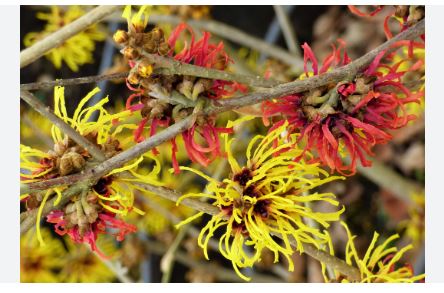
Hybrid Witch Hazel (Hamamelis × intermedia) is a cross between Hamamelis japonica (Japanese Witch Hazel) and Hamamelis mollis (Chinese Witch Hazel), belonging to the Hamamelidaceae family. This hybrid has been cultivated to combine the best traits of both parent species.
As a hybrid, Hamamelis × intermedia doesn’t have a native area in the wild; it’s a garden creation, first developed in Europe in the late 19th century. However, its parents are native to Asia.
The history of Hamamelis × intermedia begins with horticultural efforts to combine the vibrant, fragrant flowers of H. mollis with the hardiness and color variability of H. japonica. Introduced in the late 19th century, particularly in England and Germany, this hybrid has become one of the most popular witch hazels for landscaping due to its ornamental qualities.
Hybrid Witch Hazel is a deciduous shrub or small tree that typically grows to 12 to 15 feet in both height and spread. It’s famous for its winter to early spring blooming, with flowers that can range in color from yellow to orange, red, and even purple in some cultivars. The flowers are fragrant, spidery, and very showy against the bare winter branches. Leaves are oval, with serrated edges, and turn yellow to copper in autumn. Like other witch hazels, it produces woody capsules that explosively release seeds.
This hybrid is hardy in USDA Zones 5 through 8, inheriting good cold hardiness from its parents, making it adaptable to a wide range of climates, particularly where winters are cold but summers aren’t excessively hot.
With proper care, Hamamelis × intermedia can live for many decades, often over 50 years. Its slow growth and robust nature contribute to a long lifespan in well-suited environments.
Landscape Uses
Hybrid Witch Hazel is highly valued for various landscape applications:
- Ornamental Value: Its colorful, fragrant flowers provide a spectacular display during winter, making it a prized plant for ornamental gardens.
- Winter Interest: The bloom time and scent make it an exceptional choice for gardens where winter color and fragrance are desired.
- Screening: Its dense growth habit is suitable for creating natural screens or informal hedges, especially where its beauty can be appreciated.
- Sensory Gardens: The strong fragrance of some cultivars makes it ideal for gardens designed to engage multiple senses.
- Pollinator Attraction: Although not a primary source, its early blooms can attract some pollinators in late winter or early spring.
- Urban Landscaping: Adaptable to various soil types and tolerant of urban conditions, it’s well-suited for city gardens.
- Specimen Planting: Many cultivars, like ‘Diane’ with its deep red flowers or ‘Arnold Promise’ with bright yellow ones, are used as focal points due to their striking appearance.
- Shade and Woodland Gardens: Its understory origin means it can thrive and add color to shaded areas or woodland settings.
Hybrid Witch Hazel (Hamamelis × intermedia): Cultivation
Selecting the Ideal Spot
Hybrid Witch Hazel thrives in locations with full sun to partial shade. Morning sun with afternoon shade is particularly beneficial, especially in warmer climates, to protect the plant from excessive heat while ensuring enough light for flowering.
Soil Requirements
This plant prefers well-drained, fertile, loamy soil but is adaptable to sandy or clay soils if drainage is adequate. A slightly acidic to neutral pH is ideal, but it’s quite forgiving. Amending heavy clay with organic matter can enhance drainage and fertility.
Planting
Plant in either spring or fall. Dig a hole twice as wide as the root ball but only as deep. Place the plant so that the root collar is level with the soil, backfill with soil, and water well to settle the soil around the roots.
Watering
Water regularly during the establishment phase, which could take a couple of years. Once established, Hybrid Witch Hazel is relatively drought-tolerant, but deep watering during extended dry periods will support health and blooming. Avoid waterlogging, which can lead to root rot.
Mulching
Apply a 2-3 inch layer of mulch around the base to help retain soil moisture, regulate soil temperature, and suppress weeds. Keep mulch away from the trunk to prevent moisture-related diseases.
Pruning
Pruning is minimal, mainly for removing dead or diseased branches or shaping. The best time to prune is right after flowering in late winter or early spring before new growth starts, as it blooms on old wood. Avoid excessive pruning to not compromise the next year’s flowers.
Fertilization
Typically, fertilization isn’t necessary if the soil is already fertile. If growth seems slow or the plant lacks vigor, a light application of a balanced, slow-release fertilizer in early spring can help, but avoid over-fertilizing which might lead to lush foliage at the expense of flowers.
Pest and Disease Management
Hybrid Witch Hazel is generally pest-resistant but can occasionally suffer from aphids, scale, or fungal diseases like powdery mildew in humid conditions. Good air circulation and avoiding overhead watering can prevent fungal issues. Insecticidal soap can manage minor pest problems.
Propagation
Propagation can be challenging; it’s usually done through softwood or hardwood cuttings taken in late spring or fall. Seeds are less commonly used due to the variability in offspring. Cuttings from selected cultivars ensure the propagation of desirable traits.
Growth Control
While not aggressively suckering like some other species, check for and remove any unwanted suckers if you need to manage its spread or maintain a specific shape.
Winter Care
In its hardiness zones, it’s cold-resistant, needing no special winter care. However, a mulch layer can protect young plants or those in very exposed positions from frost heave.
Landscape Integration
Plant where its fragrance and color can be enjoyed, such as near paths, windows, or in sensory gardens. Its winter blooms make it a key player for extending garden interest. Consider companion planting with species that bloom at different times to provide continuous garden appeal.